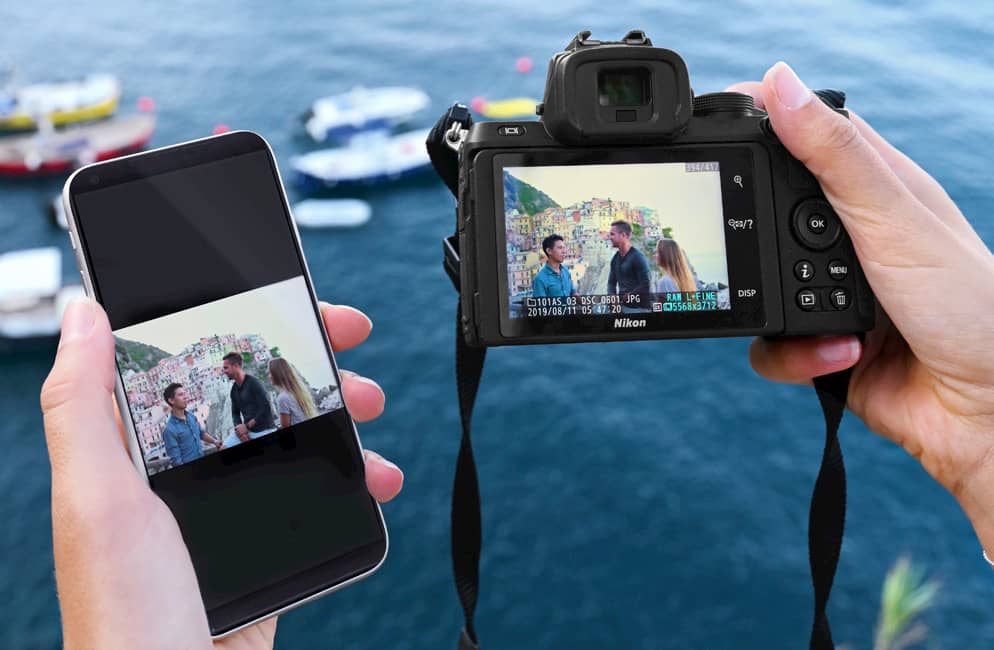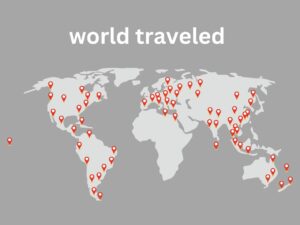Travel photography with a camera or smartphone – what should you take for your trip?
Traveling is one of the happiest and most meaningful ways to spend your time, taking you to incredible places.
Always surprising you and bringing you unexpected situations that help you connect with yourself.
When you return home, photos and videos are undoubtedly the best way to remember the experience.
In addition to bringing all experiences back to life and living them again.
Find out the importance of taking travel photography.
We compare smartphone versus digital camera to determine which is best for travel photography.
The dilemma of whether or not to take a camera on your trip is a very personal one. Each traveler will have their arguments for or against.
The constant presence of a smartphone near you makes it ready for candid, on-the-go photography.
However, the discussion will not be about choosing one or the other, but rather taking an extra camera in your luggage.
We all know how important it is to take what is absolutely necessary.
See the article about saving on tickets
Your phone is always with you, while the camera is now an extra. Whether or not to have a camera in your luggage is a decision that must be made according to each traveler’s needs.
See the importance of taking photos on your trips
Taking photos on your trip is essential, so the question is?
Take photos of your trips with a smartphone or topographic camera?
But before talking about the pros and cons of each one, it is essential to have a clear idea of what each piece of equipment is and how they differ.
DSLR vs smartphone: the difference.
First what is DSLR, or Digital Single-Lens Reflex camera, is a type of camera that combines the optics and mechanisms of a single-lens reflex camera with a digital image sensor.
They are known for their superior image quality, interchangeable lenses, and manual controls.
This makes them a popular choice among professional photographers and serious amateurs alike.
On the other hand, the smartphone camera is the camera built into your cell phone. Over the years, smartphone cameras have seen significant advancements, with multiple lenses, high megapixel counts, and a host of features that were previously exclusive to high-end cameras.
The biggest advantage of smartphones is their convenience – they are compact, easy to use and always with you.
While both DSLR and smartphone cameras can take stunning photos, they each have their strengths and weaknesses.
A DSLR offers more control and better image quality, but it is also bulkier and more complex to use.
A smartphone, while not as powerful as a DSLR, offers portability and simplicity, making it useful for capturing candid moments.
Every traveler wants stunning photos from their trips, but things get confusing when it comes to deciding whether to carry a bulky camera or just free up extra space in your phone’s memory.
If you want to know what types of cameras exist, see this article.
Here are some tips to keep in mind when choosing between a phone or a camera.
What are you going to take photos for?
Due to the evolution of smartphones, their photo quality certainly competes with some of the best consumer cameras.
One of the first questions that will definitely help is knowing what will you use your content for?
Is it to share with friends on your social networks?
Are you an aspiring content creator and would like to grow your audience with amazing images?
Is there any chance you’ll need your photos included in a professional project in the future?
What format, when and how will you post your photos.
The answers to these questions have started to tip the scales one way or the other, but it is the combination of these first factors and many others that will give you a certain idea of what best suits your needs.
If you are going to publish on networks, Tik Tok etc. – Better to use your smartphone, as it is already in the network format.
If you have, in addition to social media, a blog or some more professional work, better use a camera.
What type of trip are you going to photograph?
Admire the Northern Lights, sunbathe in the Fernando de Noronha archipelago or go hiking in the Himalayas? Every trip is different, and there is no general rule or professional consensus on which type of gear is best for a given trip.
Your itinerary will give you its own clues. Destination, weather and the type of activities you will undertake during your trip are key when deciding on your photography equipment. Does your device meet these conditions?
Think about the weight and size of the chosen tool, combined with the means of transport during travel, which are crucial for your comfort.
If you’re taking a gap year to backpack around the world, traveling light will be a priority, but if you’re spending a week at the beach and commuting by car or taxi, the weight and size of a camera will be something you won. It doesn’t bother you at all.
Traveling with difficult environments like ice, underwater photography, lots of light or low light you need a camera.
What quality are you looking for?
When it comes to image quality, DSLR cameras typically have the edge. Thanks to their larger image sensors, DSLRs can capture more light and detail, resulting in superior image quality, especially in low-light conditions.
If you plan on printing or enlarging travel photos, a DSLR would be your best bet. The superior quality of DSLR photos becomes quite noticeable in these scenarios.
However, if your photos are primarily for sharing, most phones offer excellent photo and video quality.
Most people can’t tell the difference between images taken with a phone and a camera.
In fact, if you are a blogger, high-resolution images produced by DSLR camera can slow down your website.
In contrast, smartphone cameras produce smaller files that are more web-friendly while still offering good quality for digital viewing. So if your main goal is to share your family’s travel adventures online or maintain a travel blog, a smartphone camera may be more practical.
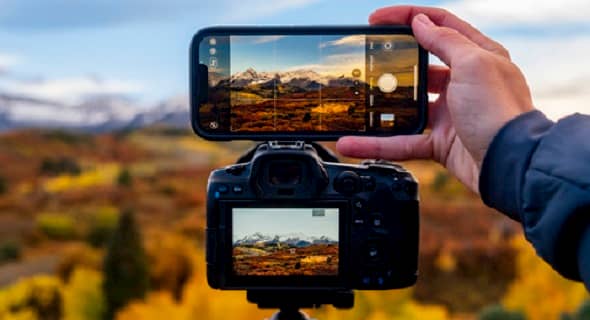
What level of performance do you want?
When it comes to performance, there’s a lot to keep in mind, both in phones and cameras.
While the image stabilization of cameras has been improved allowing you to zoom, take close-ups and capture night scenes with great clarity, the digital stabilization of high-end phones also looks amazing.
However, if you also want to access manual shooting, be able to play with focus while filming, fully open the diaphragm, set white balance details, and meticulously choose your shutter speed, you may need to opt for a camera.
Plus, with a phone, you might never combine a camera in low-light photography.
What format do you want?
Both phones and cameras allow you to film or take photos in a wide variety of formats, but if you plan to create videos for social networks such as IG or TikTok, you may find it much easier and more comfortable to film in a vertical format (9:16) with your phone. Rotating your camera 90 degrees feels strange.
So for network lovers, a smartphone is the best option, and many of the tools are only available for smartphones.
Connecting to Wi-Fi
While most cameras have a Wi-Fi connection to download your photos directly to your phone, whether you’re a content creator, influencer, or just a dedicated Instagrammer or TikToker, it’s always easier and faster to share what you’ve created natively with your phone.
Also, for live streaming, a camera won’t be able to help.
Battery life.
It’s not just about how long the batteries last, but also how many batteries you’ll need to carry and how bulky your camera battery chargers are. While your phone can last all day without needing to be recharged, carrying extra batteries for your camera and a battery charger can be a pain if you’re traveling for a long time or in remote areas.
Lenses and accessories
Photography is all about light, and before it reaches the sensor, light travels through a lens. The quality of your lens and its internal composition will define the sharpness of your image, allowing you to play with different depths of field.
Nowadays, phones incorporate several good quality lenses to give the photographer several options that are more than enough for the average traveler, but if you’re looking for a handcrafted look, there’s nothing like a camera with interchangeable lenses.
If you need lenses and accessories, such as filters, etc., there is nothing better than having a camera.
You can find all types of accessories for any situation
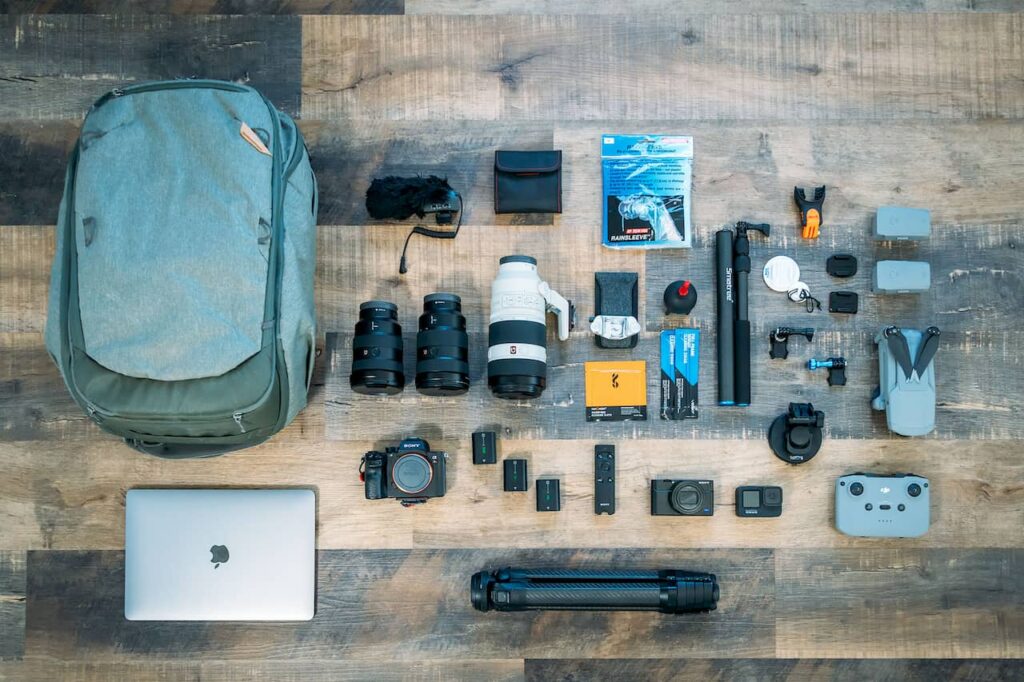
Image editing
Your photograph isn’t yet finished when you hear the shutter click, which is why editing features for captured files are vital for flexibility in posting.
The phones include built-in editing tools that are good enough for sharing amateur content on social media.
However, if you need to be a little more professional, cameras offer a wider variety of professional formats for photo and video files.
Factors to Consider When Choosing Between a DSLR and a Smartphone Camera
Now that you know the pros and cons of DSLR camera vs phone camera, there are several important factors to consider when deciding to invest in a camera or phone for travel photography.
Convenience versus Quality:
DSLR cameras are known for their superior image quality, but this comes with a disadvantage in terms of convenience. DSLRs are heavier and bulkier than smartphones. In addition to the camera itself, you’ll likely need to carry essential accessories like a lens, tripod, and spare batteries.
On the other hand, smartphones offer a high level of convenience. They’re lightweight, compact, and something most of us carry with us anyway. This makes them a practical choice for travel photography, especially when you’re dealing with the demands of young children.
Additionally, the quality of smartphone photos has improved dramatically in recent years.
So when deciding between a DSLR and a smartphone camera, consider your specific needs and circumstances. If convenience and ease of use are your top priorities, a smartphone camera might be the best choice.
However, if you’re willing to carry extra gear for higher image quality, a DSLR may be worth the extra effort.
Resolution:
There are many smartphones with very high-resolution sensors these days.
However, does a smartphone need 200 MP resolution? No, not particularly, and they are generally not used to capture 200 MP images.
On the other hand, digital cameras are generally more conservative in their resolution. Many average somewhere around 24 megapixels, but you can get higher resolution counts for photography details or if you plan to print your images.
The problem with high resolutions is that they are unforgiving – a small focus error or a bit of blur caused by camera shake is much more obvious when captured in millions of pixels.
If you want to use high resolutions to make image prints, then a camera is probably the best option.
Durability:
DSLR cameras, while robust in their own right, can be quite delicate. They need to be handled carefully, protected from the weather and maintained regularly.
I always make sure I protect my Nikon camera from wind and rain, handle it carefully and clean it before each use.
Smartphones have the necessary protections to operate without much care other than falling.
Smartphones have a much shorter lifespan and as a result we are always changing devices.
Cameras last longer than smartphones.
Auto Focus:
In many genres of photography, a good, reliable autofocus system is often the difference between getting the shot right and missing it completely. If you like photographing the street, action or wildlife, i.e. things in motion, then you need a focus system that locks quickly.
Smartphone autofocus has already improved a lot.
However, digital camera autofocus has improved much more.
The Camera is the best option in this case
Lenses and accessories:
Most high-end smartphones these days feature at least three lenses, with quad-lens arrays currently the standard on flagship models.
This usually involves a “standard” lens, an ultra-wide lens, and often at least one telephoto (zoom) lens. This offers a good degree of flexibility for capturing images at a variety of different focal lengths.
Compact cameras will have a lens, but generally this is an optical zoom lens that covers a range of different focal lengths.
DSLRs and mirrorless cameras have interchangeable lenses, with dozens of options available depending on what you like to photograph.
There are also a variety of specialized optics, such as those good for shooting close-up images (macro lens), ultra-wide angles, and so on.
This means you’ll end up with a bag full of different lenses, which is less convenient than shooting with your phone – but much higher image quality.
Cameras are unbeatable in the availability of lenses and accessories.
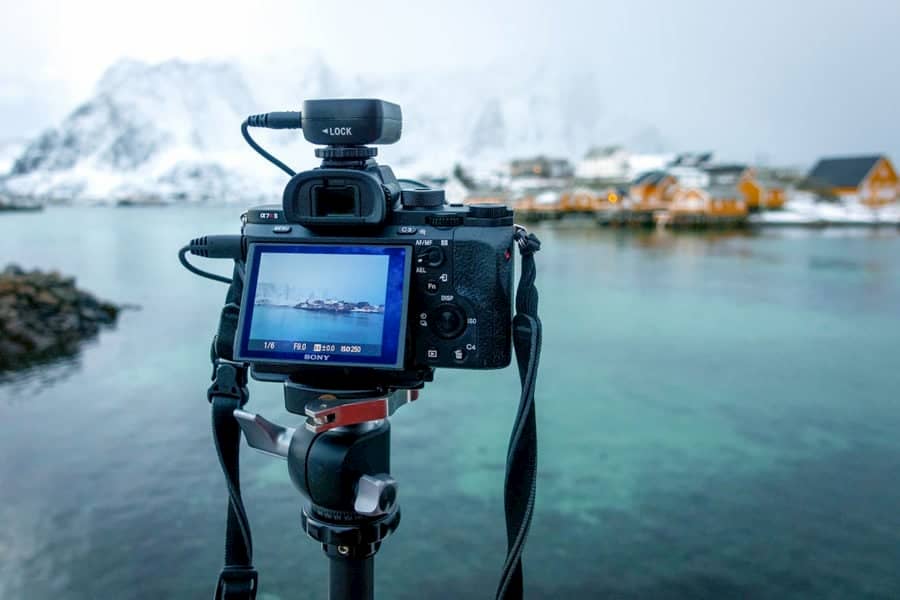
Ease of use:
Many prefer the treatment of a “proper” camera, with buttons that give direct access to settings and the like.
On the other hand, a smartphone’s camera is usually controlled by on-screen buttons and menu selections. Many smartphones let you use a physical button to release the shutter, but of course there’s no grip or sturdy body to hold.
Another thing worth considering is manual control. Some smartphones have this feature in their native apps, which means you can change settings like ISO, shutter speed, and so on.
Most dedicated cameras have manual and semi-automatic controls, giving you even more room to change any desired setting. It is worth remembering, however, that for many, the simplicity of operating a smartphone will also be attractive.
Screens and Displays:
With smartphones, it’s usually all about the screen – as that’s how you’ll operate most of its functions. High-end smartphone screens are incredibly good now.
On the other hand, digital camera screens are completely different. While resolutions have increased over the years, you’re unlikely to find a camera screen that matches a smartphone’s resolution.
Some cameras have fixed screens, which aren’t particularly useful if you want to take selfies and video content. On the other hand, on a smartphone, you have to switch to the front camera, which is not as good as the rear camera.
Many cameras have tilting or articulating screens, meaning you can face them forward when taking photos or recording videos – making them ideal for content creators.
Additionally, many cameras also have a built-in viewfinder, which many find preferable for shooting. Electronic views have also improved over the past ten years, so there is no longer this battle between optical and electronic devices.
Size:
The best travel cameras are those that offer a good degree of flexibility that surpasses the quality of your smartphone. Now you can get excellent (relatively) small cameras that make great travel companions without compromising too much on image quality.
I use a Nikon A900.
That said, there’s no getting away from the fact that smartphones are much easier to use. Especially since you’ll be carrying one anyway, if traveling as light as possible is a top priority, smartphones are the obvious choice.
Video:
Smartphones are great for capturing video, due to their simplicity of use and a range of tools available.
Such as time-lapse, slow motion and so on. Many smartphones even offer video editing as a native app, and there are hundreds of apps you can download to do this work for you.
Digital cameras are also excellent for video, but as a rule, they may require a little more specialist knowledge to get the most out of them. You will almost certainly need a third-party video editor to work with your footage.
For video, the best option is a smartphone.
Convenience:
Smartphones are great for capturing video, due to their simplicity of use and a range of tools available.
Such as time-lapse, slow motion and so on. Many smartphones even offer video editing as a native app, and there are hundreds of apps you can download to do this work for you.
Digital cameras are also excellent for video, but as a rule, they may require a little more specialist knowledge to get the most out of them. You will almost certainly need a third-party video editor to work with your footage.
For video, the best option is a smartphone.
Connectivity:
Almost all modern cameras have built-in Wi-Fi and/or Bluetooth, which means you can connect them to your smartphone to quickly share your images online or via email and social media. Some are easy to use and transfer images, while others are frustratingly complicated and don’t always work the first time.
This simply isn’t a problem for the smartphone, which obviously has the connection built in. If you share socially, there’s no faster way than shooting on your smartphone and sharing immediately.
And if you want a camera so you can send emails and share photos immediately, a smartphone is your best choice.
Price:
The price is a little complicated, as is considering the cost-benefit ratio. Both smartphones and cameras are available in different price ranges, with some being more affordable than others.
Although it is true that the smartphone offers more flexibility and is undoubtedly the best value for money.
Since you’re going to have one anyway, it’s worth buying the best smartphone for photography.
However, it’s also true that you can buy a low-cost smartphone and invest the money you save in better photography equipment.
Since you will buy the smartphone anyway, its cost will be much lower.
So which one is better for travel photography? Smartphone or Digital Camera?
Algumas questões são mais difíceis de responder do que outras. Os smartphones são ótimos, assim como as câmeras digitais.
Porém, a resposta sobre qual é a melhor para a fotografia de viagem é subjetiva e dependerá de vários fatores.
Ao decidir o que é melhor para você, você precisará decidir qual fator é mais importante para você.
Para ter uma visão mais clara vou responder esta pergunta em 3 respostas.
Cada uma conforme o objetivo da viagem e que tipo de “fotógrafo você é”
1 - Common trips, like traveling to a city and being the least demanding traveler with photos.
A smartphone is ideal, as in addition to being practical, it takes photos in the format and quality of the networks.
You already have a smartphone, you might just have to buy one with the best cameras for your next purchase.
2 - Travel such as trails, animal photography, photography at night.
The best thing is to combine a great smartphone and a DSLR camera.
This gives you the ease and flexibility of the smartphone and the precision and options of the camera.
I prefer this option as I have a Nikon mirrorless camera, a Hero camera and a Samsung smartphone.
See my trip to Thailand where I used all 3 pieces of equipment, including underwater video
The only thing you have to pay attention to is the format of the photos.
So it’s better to photograph the entire moment with the camera or smartphone.
This avoids having to mix the two formats.
3 - For very special trips such as bird watching, speed sports, northern lights, photography in water, etc.
In this case, a DSLR camera is essential, as the need for special lenses and accessories is enormous and only cameras have these options.
I have a Hero camera for photos and videos on my dives, with a filter for open water, buoyancy.
Tripod for Nikon camera, with remote control, etc.
Digital cameras offer more flexibility when it comes to lenses and accessories.
Smartphones are much better for quickly sharing your images and videos online.
And you. What is your opinion?
Leave your comment.
